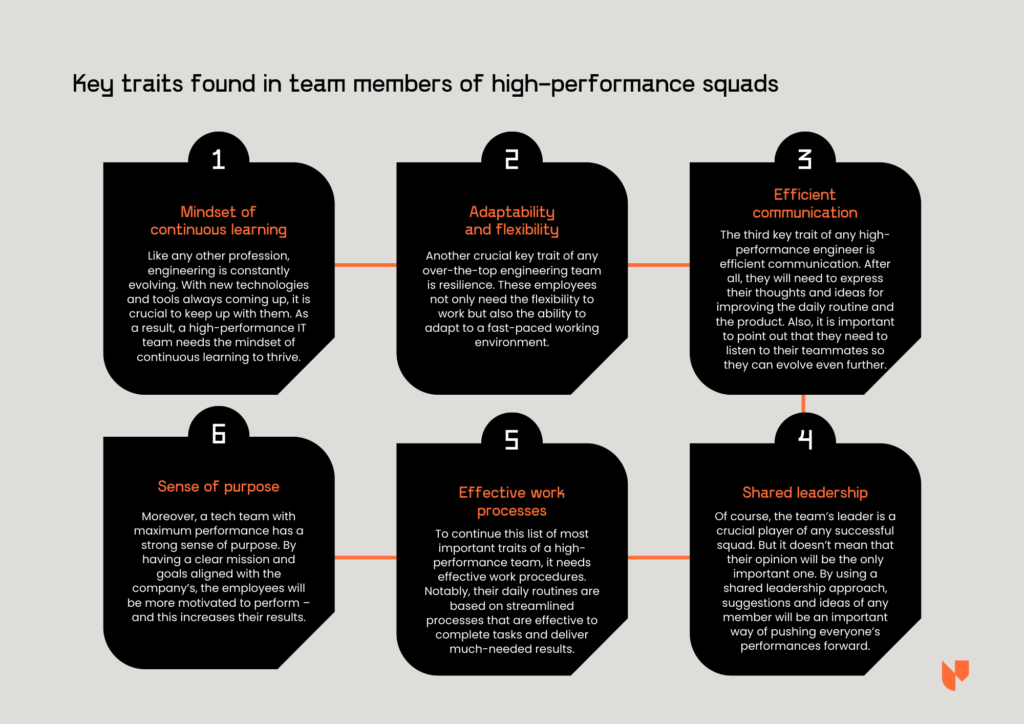Building a high-performing engineering team is crucial for software development success. This guide explores essential practices like Agile development, fostering team collaboration with the right tools, and strategies for leading remote engineering teams.
Food for Thought
Software companies, even at early stages, must embrace high-performance engineering teams – and not settle for less. You need to keep your performance high. That’s is why the leader has to be aligned with the objectives of the work. In fact, the smaller the team, the higher its seniority should be.
After all, smaller companies are more susceptible to risk and cannot afford as many mistakes so as not to compromise a company and product brand still under development. Fortunately, this process can often be measured using metrics to obtain a more efficient result. So how can you make sure your team will deliver, from the MVP to the ideal product launch? Read on to find out how to set up the development of any project to promote the achievement of goals.
Software development is a market as competitive as it is profitable. Because of this, a high-performance engineering team is crucial for any company that wants to achieve relevant results. As vast as this concept may look like, it is all about the right mindset, and, of course, CTOs and Directors of Engineering have a crucial role in leading them. But what should they know to increase their employees’ productivity?
How to recognize high-performance engineering teams?
There are many definitions of what a high-performance engineering team is. The best one is Brian Zotter’s: they sustainably offer long-term productivity. According to the VP of Product Engineering at Medium, one crucial trait is the ability to achieve the desired results while always finding new ways to improve.
It isn’t an overstatement to point out that a high-performance engineering team is all about its culture. Things such as their habits, behavior, and value system are crucial to creating over-the-top products. The culture of a high-performance team is also based on the sense of purpose in their work.
Furthermore, it should be noted that a high-performing team needs to be well structured. After all, every member needs to know not only their responsibilities but also expectations, accountability, and goals.
Besides, a high-performance engineering team has psychological safety to perform well. As a result, the employees feel confident to express their ideas and explore their creativity, while also having the support to ask for help and evolve from eventual mistakes.

Key traits in members of high-performance squads
Key traits found in team members of high-performance squads
And how can you know what are the key traits of any high-performance tech team? Here is a list of the most important things a high-performance squad should have:
1. Mindset of continuous learning
Like any other profession, engineering is constantly evolving. With new technologies and tools always coming up, it is crucial to keep up with them. As a result, a high-performance IT team needs the mindset of continuous learning to thrive.
2. Adaptability and flexibility
Another crucial key trait of any over-the-top engineering team is resilience. These employees not only need the flexibility to work but also the ability to adapt to a fast-paced working environment.
3. Efficient communication
The third key trait of any high-performance engineer is efficient communication. After all, they will need to express their thoughts and ideas for improving the daily routine and the product. Also, it is important to point out that they need to listen to their teammates so they can evolve even further.
4. Shared leadership
Of course, the team’s leader is a crucial player of any successful squad. But it doesn’t mean that their opinion will be the only important one. By using a shared leadership approach, suggestions and ideas of any member will be an important way of pushing everyone’s performances forward.
5. Effective work processes
To continue this list of most important traits of a high-performance team, it needs effective work procedures. Notably, their daily routines are based on streamlined processes that are effective to complete tasks and deliver much-needed results.
6. Sense of purpose
Moreover, a tech team with maximum performance has a strong sense of purpose. By having a clear mission and goals aligned with the company’s, the employees will be more motivated to perform – and this increases their results.

How Leaders Can Empower Teams for High Performance
High-performance can only be achieved with the leadership’s full support. CTOs and Directors of Engineering need to empower their staff so they can achieve over-the-top performance. But how?
To begin this list, it is impossible not to point out that a team will be empowered when their leaders build trust. With well-established relationships between co-workers and leadership, the daily work will be easier – and healthier.
Secondly, the leader must ensure a streamlined engineering process. By knowing the team’s needs, the leadership will be able to optimize the daily processes and increase performance. This will prove crucial especially when the team expands.
Communication is another key point of this empowerment. Not only by always aligning strategies and tactical details to the members but also by discussing how to improve their work experience. The less you communicate, the less your employees will perform.
Lastly, the leader has the responsibility of encouraging teamwork. With every member sharing their knowledge and supporting each other, it will be easier to deliver a high-quality product.
Foster a Culture of Collaboration and Innovation
- Open Communication: Encourage open and honest communication among team members.
- Knowledge Sharing: Promote knowledge sharing through regular team meetings, pair programming, and code reviews.
- Cross-Functional Collaboration: Facilitate collaboration with other departments to ensure alignment and understanding.
- Innovation Workshops: Organize workshops to brainstorm new ideas and explore innovative solutions.
Prioritize Continuous Learning and Development
- Provide Training Opportunities: Offer training courses, workshops, and conferences to enhance team skills.
- Encourage Self-Learning: Foster a culture of continuous learning and encourage team members to explore new technologies and methodologies.
- Mentorship Programs: Establish mentorship programs to pair experienced engineers with junior team members.
- Feedback and Performance Reviews: Provide regular feedback and performance reviews to support growth and development.

Inclusive leaders actively create environments where everyone feels valued, respected, and empowered to contribute their unique perspectives. This fosters open communication, psychological safety, and a sense of belonging for all team members. Photo by Brooke Cagle.
Why high-performance engineering teams are crucial to business success
It would be an understatement to say that software as a service (SaaS) is promising. A study by Valuates Reports shows us that it is already a reality – with a market value of US$ 158,2 billion and the projection of reaching US$ 307,3 billion by 2026.
While the stats and figures show us that software development is in high demand, we need to point out that it is a progressively competitive market. It is important to point out that 92% of SaaS companies fail within 3 years, so this type of product needs over the top quality to thrive.
And how can you achieve this? By structuring a team of qualified software developers that can deliver the product with quality, on time, and, of course, in a profitable operation.
Measure and Improve Team Performance
- Key Performance Indicators (KPIs): Define relevant KPIs to track team performance, such as productivity, quality, and customer satisfaction.
- Regular Assessments: Conduct regular assessments to identify areas for improvement and celebrate successes.
- Retrospectives: Hold retrospective meetings to reflect on past projects and identify lessons learned.
Why Companies Must embrace High-performance engineering teams – and not settle for less
Every team member is vital to establishing how every organization functions and the results that they achieve. So yes, no company should settle for less than a high-performing team because they are crucial to becoming more competitive.
As it was said before, the sense of purpose of high-performers gives them more motivation to work and achieve the company’s goals. Also, this kind of software developer is more ambitious and will always focus on reaching far greater results.
Also, high-performance teams are run more transparently and responsibly, so every member can be more effective in their tasks – while also depending less on their leaders to do it.
To complete the list of reasons to embrace this kind of development team, the diversity of knowledge and expertise allows members to evolve together. This allows you to have better employees and earn even better results.
Prioritize Continuous Learning and Development
- Provide Training Opportunities: Offer training courses, workshops, and conferences to enhance team skills.
- Encourage Self-Learning: Foster a culture of continuous learning and encourage team members to explore new technologies and methodologies.
- Mentorship Programs: Establish mentorship programs to pair experienced engineers with junior team members.
- Feedback and Performance Reviews: Provide regular feedback and performance reviews to support growth and development.
How to create a high-performance engineering team
We mentioned earlier the key traits of a high-performance engineering team and why they are crucial – but how are they created? Firstly, you’ll need to hire the best talent and the right candidates to be a part of your team.
Moreover, it should be noted that there are different ways that you can hire professionals – and you can use more than one. That said, it is possible to mix and match in-house engineers, staff augmentation, and contractors so your team can perform even better.
Since nowadays you can hire qualified engineers all around the globe and also reduce costs, it is easier to have more in-house members in your team. This doesn’t mean that you should discard the other options, which can help you scale up performance by bringing more knowledge into the mix.
However, there is no formula of how many of your team’s members should be your own employees or outside personnel temporarily. After all, this answer depends on your budget and the project’s demands.
How to run a high-performance engineering team that keeps on evolving
Sure, you can follow the steps mentioned above about how to empower your high-performance team. But beware: they are not the only steps in the ultimate guide on how to run a high-performance team.
Embrace Agile Development Methodologies
- Iterative Development: Break down projects into smaller iterations to deliver value incrementally.
- Continuous Integration and Delivery (CI/CD): Automate the build, test, and deployment process to improve efficiency.
- Scrum or Kanban: Implement Agile frameworks to manage projects effectively.
- Agile Values: Emphasize collaboration, customer satisfaction, and continuous improvement.
Leverage Effective Team Communication Tools
- Project Management Tools: Use tools like Jira, Asana, or Trello to track tasks, manage projects, and collaborate effectively.
- Communication Platforms: Utilize platforms like Slack, Teams, or Zoom for real-time communication and collaboration.
- Version Control Systems: Implement version control systems (Git, SVN) to manage code changes and collaborate on projects.
To keep your operation evolving, it is crucial to consider every aspect of the Software Development Lifecycle (SLDC). Here is a list with all of the key points of running a high-performance team:
High-performance during Planning in software development
Let’s begin with the planning part of software development. Firstly, you need to define your goals and also the scope of the project. Both need to be aligned to the company’s mission.
Also, it is crucial to analyze every resource that will be available to your project so the budget allocation will be precise. By knowing which tools and professionals will be needed, you’ll be able to create the project’s schedule and build a team that can deliver it.
Bear in mind that planning is something that needs to be done not only during the project’s conception. It is crucial to adapt to any situation that may occur – we will discuss it more in the next phases.
High-performance during Analysis in software development
The second step in software development is analysis. Here, all of the end-user business requirements will be analyzed to define every system and role of every team member.
For this reason, you’ll need to gather a wide range of business requirements – after all, more information means a more accurate analysis of what your software will need to be successful.
Also, you’ll obviously need to thoroughly analyze all of the data collected. With this in mind, it is crucial to draw process flow diagrams so it is easier to understand the role of every major component – this will help the workflow to be optimized and, consequently, more efficient.
High-performance during Design in software development
And how about the step when all of the features of the software will be created? While the design phase contains things such as screen layouts, it is important not to focus on aesthetics – the main focus is how the software will function.
Here, the system model and the IT infrastructure are created and developed. To do it properly, a high-performance team needs to optimize the system so it can perform with the available resources, expected load, and, of course, determined goals.
Moreover, a high-performance team sticks to the SOW to avoid risks – as a result, score creep is something that needs to be an expression missing from your glossary. This will allow you to develop efficient software.
High-performance during Testing and Integration in software development
Obviously, your engineering team will need to test the software before it is released. Here, the code must be integrated so bugs and errors can be found. Want to scale up this process? You’ll need a well-defined scope of testing so the testers can perform better.
Furthermore, the tests need to be well planned and documented. Also, it is crucial to determine how they will be done and the configurations of the testing environment. If this step isn’t thoroughly done, the software may be released with many faults – which is dangerous.
High-performance during Implementation in software development
After the software is developed, it will need to be implemented. To optimize your implementation team’s performance, it is crucial to understand the scale of your operation – and how many users your software will have.
This will allow you to build this team so it can have all the needed members. Bear in mind that this process is in constant refinement after kick-off, so changes are to be expected to improve the software’s experience.
Also, the first software buildout is a crucial part of the implementation, so it needs to be sent to the client’s necessities. Of course, you’ll need to offer support so they can use it the way you expect.
High-performance in software maintenance
The last step of the software development process is continuous: maintenance. Sure, the best-case scenario is that corrections and enhancements won’t be needed that often – but let’s be honest: they are inevitable.
Due to the natural evolution of your user needs, your software will always have to adapt itself – not only by finding bugs and other running issues but also by changing functions. Your team needs to be focused on improvements.
The best way of doing it is putting all of the maintenance-related into the product’s backlog of tasks. It is an efficient way of prioritizing tasks and optimizing the process so it can be more effective.
Essential elements to help engineers work on teams more successfully
While a high-performance software development team can be co-located, remote, or distributed, it is important to realize that all of them can be helped by the same essential elements.
Firstly comes the team’s culture and mindset. They need a clear vision of what needs to be done, the culture code, and even their goals. Because diversity brings different approaches to problem-solving, it is essential to include everyone so they can feel more comfortable contributing.
Also, the workspace needs to be well structured so your developers will be able to perform – be it in a physical place or a remote one. And, of course, they will need hardware, software and internet connection to work.
Equally important is streamlining the team’s processes. Not only is it crucial to reassess them, but also look for new tools that can be useful. The focus here is on optimizing, so the right tech stack is the one with less software and higher scalability.
To finish the list of the best practices of high-performing engineering teams is always determining responsibility for every task. This, summed up with a culture of transparency and trust will help your employees to sky-rocket their performance – remember: leadership is essential to it.
Interested in how you can streamline your team’s processes? Drop us a line.
FAQ on High-Performing Engineering Teams
- What are the key characteristics of a high-performing engineering team?
Strong collaboration, shared goals, continuous learning, and a focus on quality. - How can I improve collaboration within my engineering team?
Foster open communication, encourage knowledge sharing, and use effective collaboration tools. - What are some best practices for leading remote engineering teams?
Set clear expectations, provide regular feedback, build trust, and utilize technology to facilitate communication. - What tools and resources can help me build a high-performing engineering team?
Consider using project management tools, communication platforms, and learning resources to support your team’s development.

International Marketing Leader, specialized in tech. Proud to have built marketing and business generation structures for some of the fastest-growing SaaS companies on both sides of the Atlantic (UK, DACH, Iberia, LatAm, and NorthAm). Big fan of motherhood, world music, marketing, and backpacking. A little bit nerdy too!


